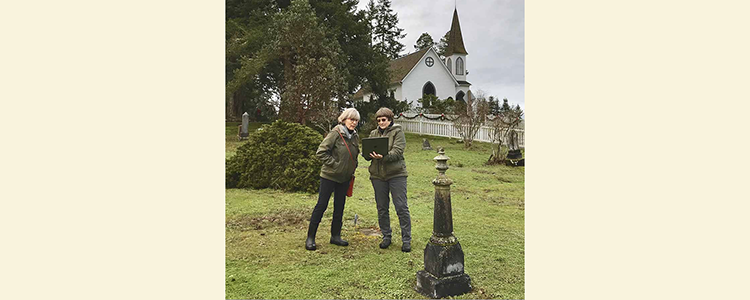||| FROM SALISH CURRENT |||
On a clear day, from the hill at Lopez Island’s Union Cemetery, the Olympic Mountains range across the southern horizon and Mount Baker peeps out to the northeast. Sheep here, cattle there range in the pastures below the rural-Gothic-style Center Church. Lilacs brighten the air in spring; red foliage evokes New England in the fall.
Who wouldn’t want their loved ones buried in a spot like this? And that’s the problem. Union Cemetery, established 17 years after the Civil War, is running out of space.
Marty and Cass Clark, sisters who volunteer and share the role of sexton, use a computer program that displays plots as occupied, purchased but still empty, or available, to track the 53 casket plots available in the newer section and perhaps 200 more in the older section.
The Clarks have been selling plots and keeping records since 2014 for the Lopez Union Cemetery Association (LUCA) board which oversees fundraising and maintenance for the cemetery, one of only a handful of nonprofit cemeteries in the nation.
The challenge the Clarks face is the same as with many older, rural graveyards Cass explained: “The records are spotty.” In some sections, she said, “We realized we really couldn’t sell plots because it wasn’t clear whether anyone was buried there.”
Plots are in high demand in part because the cemetery’s fees are modest. A casket plot costs $900; an urn plot $700.
Marty said she sold a plot to someone “who said it would have cost $35,000 in Seattle.” The Clarks declined to sell to a family group from California who wanted to buy 16 plots at once. The LUCA Board has since declared that residency (including part-time) is required to buy a plot.
But is there space?
They still were left with the question of how to ensure a given plot is available.
When researching how to determine availability, board president Mary Reece learned that the prevailing method is nothing more than the extremely low-tech process of tamping: poking a six-foot iron rod straight down into the center of a plot. “If it goes ‘clunk,’ that means there’s a casket down there,” said Marty. But, “the thought of going through that process with every plot just didn’t seem respectful.”

Center Church has long been part of the view at Lopez Union Cemetery, which had been in use for about 13 years when this photo was taken around 1895. (Photo courtesy Lopez Island Historical Society)
For Reece, respect for those buried in the Lopez cemetery is personal: her ancestors rest there. Reece is a fifth-generation Lopezian whose great-great-grandparents arrived in 1869. Her great-great-grandfather’s name appears in the attendance records of the cemetery Board’s first meeting, in 1883.
One forebear, Henry Brown, son of widely known “Mother” Mary Brown (Reece’s namesake, a Coast Tsimshian woman born in Metlakatla, British Columbia, as Conna [k-naugh], who became an important liaison between native people and settlers on Lopez), drowned at sea. It’s unclear whether his grave is occupied. But Reece, too, dislikes the idea of tamping: “It’s important that I’m not going to disturb Henry.”
Reece became board president six years ago. Having served on the Lopez Island Historical Society’s board, she knew the graveyard’s history, including the old-timers’ lore, “They had to kill a man in order to start a cemetery on Lopez.”
According to island history, John Anderson was murdered in 1882 by his neighbor John Kay in a dispute that started about a straying cow but reportedly owed something to long-held Swede-Norwegian animus. The land was donated, John Anderson was buried, and Center Church was built five years later.
A job for radar
Reece’s search for a better way to assess whether plots are occupied led her to ground-penetrating radar, or GPR, used by archeologists. She learned that the Central Washington University anthropology department’s Cultural and Environmental Research Studies program offers its GPR team to cemeteries.
Community service, director Steven Hackenberger explained, is part of the program’s mission. While they do work on contract with larger entities such as the Puyallup Tribe of Indians, “We like to reach out to smaller projects as learning opportunities.” The CWU program worked at the Roslyn Cemetery in Kittitas County where incomplete records were similar to those on Lopez.
The GPR machine looks like a lawnmower, with a screen at the handle. “Radio frequencies go down into the ground, and as they come back up — kind of like echolocation — they’re reading slices of what they see,” Reece explained. “GPR identifies pockets of air, or shows general lumps — not pictures of bodies.”
The CWU program is supported by grants, so LUCA needs to cover only logistical costs. It’s satisfying to Reece for as small as Lopez cemetery is to be on the cutting-edge. Even Seattle’s biggest cemetery still uses tamping, she said. “So we are way ahead of the game.”
The CWU team is expected to arrive on Lopez in February. The Clarks and the board expect the GPR scanning will take two days, and may then allow for the sale of some of those 200 sites.
Changing practices
Casket burials have become less popular since the mid-1980s, in some cases because of objections such as the use of embalming chemicals that may leak into groundwater.
LUCA’s plots for cremation urns now make up more than 50% of burial requests, Marty said. Plots for cremains are only two square feet. Since up to six urns can fit into one casket plot, families often opt for the larger size.
However, with today’s carbon concerns, cremation has come under scrutiny. “People want something that gives back rather than takes away,” Marty said. The Clarks are frequently asked by Lopezians about “green burial,” but the cemetery does not meet the requirements. A green burial places a wrapped body without a casket in a 12-foot square plot with a concrete border, a much larger space than the five-by-eight-foot casket plot.
The Clarks are investigating another newly available technology: natural organic reduction (NOR), also known as human composting, or terramation. Washington state in May 2019 became the first state to legalize NOR. Oregon and Colorado have since legalized NOR; California is considering legislation.
As described by reporter Jen York, the process works by placing the remains inside a cylindrical cradle or vessel. “Bacteria and wood chips may be introduced inside the cradle as well. It is kept at a high heat and naturally breaks down remains in the following weeks,” York wrote.
NOR releases no carbon. Over two months, family members can come and visit through the whole process while the pods containing bodies are gently rolled. Each terramation results in approximately 275 gallons of soil.
FEATURED IMAGE ABOVE: Occupied or available? Lopez Union Cemetery co-sextons (and sisters) Cass (at left) and Marty Clark track plot data in their laptop. With space in the cemetery in high demand, managers plan to use a high-tech solution to survey underground and determine which plots are occupied — one of several innovations in the business of final farewells. (Courtesy photo)
**If you are reading theOrcasonian for free, thank your fellow islanders. If you would like to support theOrcasonian CLICK HERE to set your modestly-priced, voluntary subscription. Otherwise, no worries; we’re happy to share with you.**








